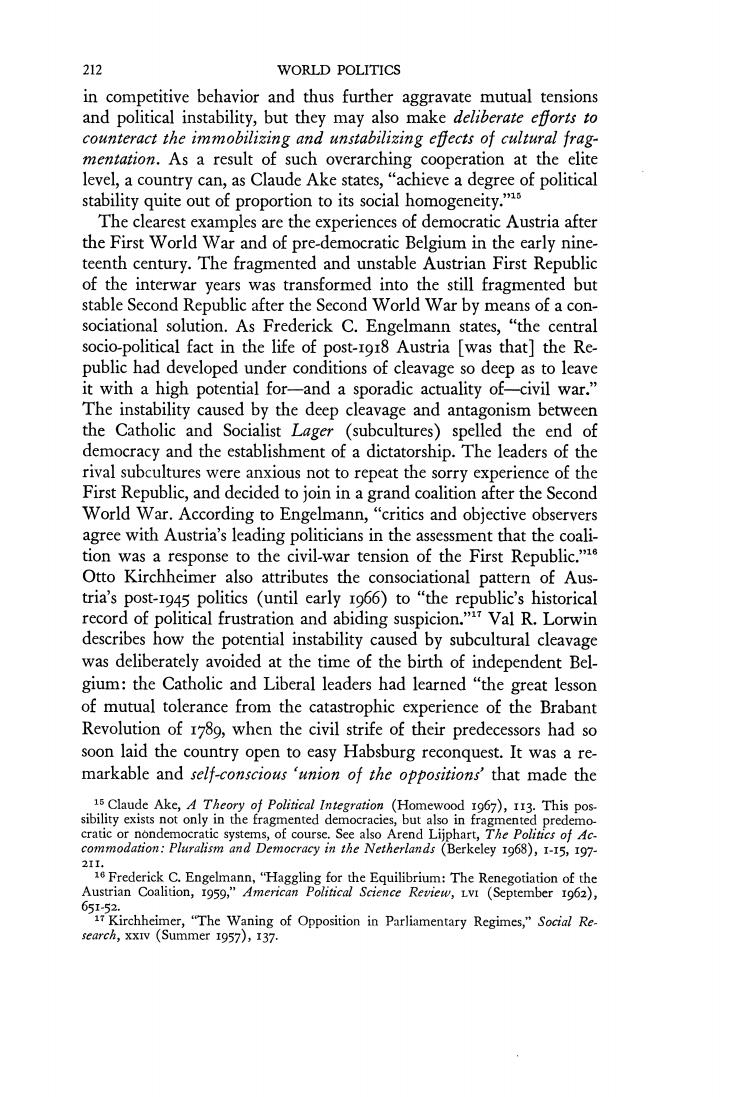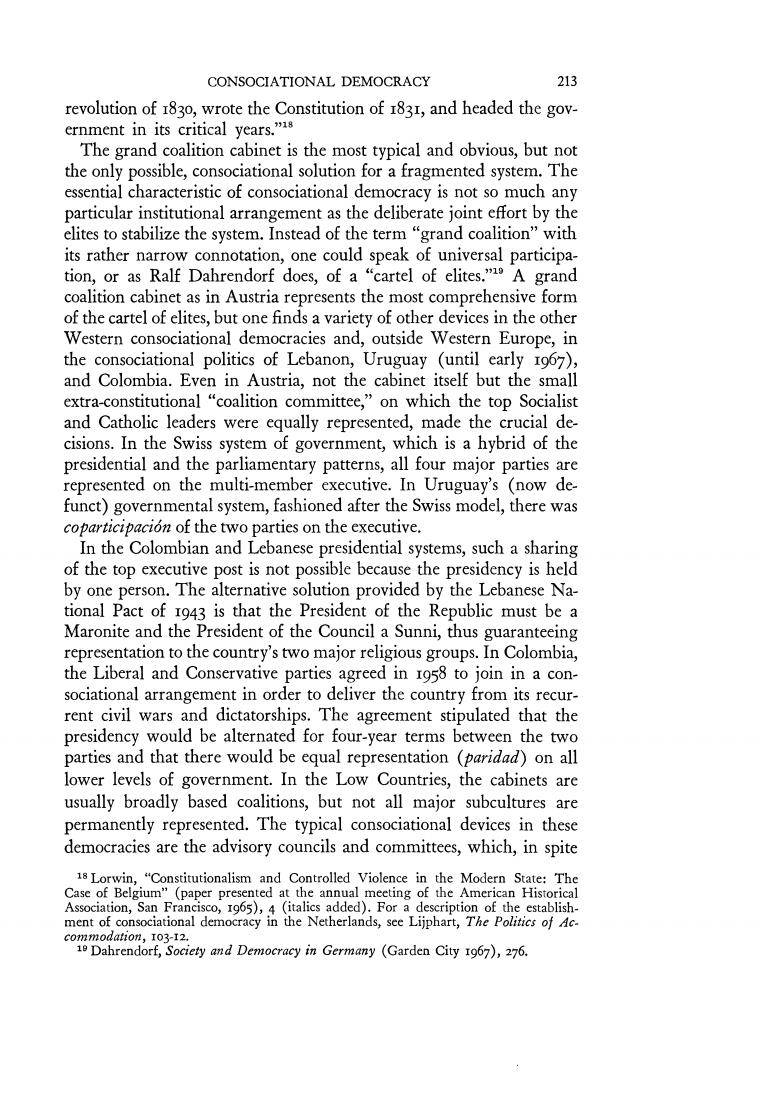
212 WORLD POLITICS in competitive behavior and thus further aggravate mutual tensions and political instability,but they may also make deliberate efforts to counteract the immobilizing and unstabilizing effects of cultural frag- mentation.As a result of such overarching cooperation at the elite level,a country can,as Claude Ake states,"achieve a degree of political stability quite out of proportion to its social homogeneity. The clearest examples are the experiences of democratic Austria after the First World War and of pre-democratic Belgium in the early nine- teenth century.The fragmented and unstable Austrian First Republic of the interwar years was transformed into the still fragmented but stable Second Republic after the Second World War by means of a con- sociational solution.As Frederick C.Engelmann states,"the central socio-political fact in the life of post-1or8 Austria [was that]the Re- public had developed under conditions of cleavage so deep as to leave it with a high potential for-and a sporadic actuality ofcivil war." The instability caused by the deep cleavage and antagonism between the Catholic and Socialist Lager (subcultures)spelled the end of democracy and the establishment of a dictatorship.The leaders of the rival subcultures were anxious not to repeat the sorry experience of the First Republic,and decided to join in a grand coalition after the Second World War.According to Engelmann,"critics and objective observers agree with Austria's leading politicians in the assessment that the coali- tion was a response to the civil-war tension of the First Republic. Otto Kirchheimer also attributes the consociational pattern of Aus- tria's post-1945 politics (until early 166)to"the republic's historical record of political frustration and abiding suspicion.Val R.Lorwin describes how the potential instability caused by subcultural cleavage was deliberately avoided at the time of the birth of independent Bel- gium:the Catholic and Liberal leaders had learned "the great lesson of mutual tolerance from the catastrophic experience of the Brabant Revolution of 1789,when the civil strife of their predecessors had so soon laid the country open to easy Habsburg reconquest.It was a re- markable and self-conscious 'union of the oppositions'that made the 15 Claude Ake,4 Theory of Political Integration (Homewood 1967),113.This pos. sibility exists not only in the fragmented democracies,but also in fragmented predemo- cratic or nondemocratic systems,of course.See also Arend Lijphart,The Politics of Ac- commodation:Pluralism and Democracy in the Netherlands (Berkeley 1968),1-15,197- 2I1, 16 Frederick C.Engelmann,"Haggling for the Equilibrium:The Renegotiation of the Austrian Coalition,1959,"American Political Science Review,LvI (September 1962), 651-52. 11 Kirchheimer,"The Waning of Opposition in Parliamentary Regimes,"Social Re- search,xxiv (Summer 1957),I37

CONSOCIATIONAL DEMOCRACY 213 revolution of 1830,wrote the Constitution of 1831,and headed the gov- ernment in its critical years." The grand coalition cabinet is the most typical and obvious,but not the only possible,consociational solution for a fragmented system.The essential characteristic of consociational democracy is not so much any particular institutional arrangement as the deliberate joint effort by the elites to stabilize the system.Instead of the term"grand coalition"with its rather narrow connotation,one could speak of universal participa- tion,or as Ralf Dahrendorf does,of a "cartel of elites."4A grand coalition cabinet as in Austria represents the most comprehensive form of the cartel of elites,but one finds a variety of other devices in the other Western consociational democracies and,outside Western Europe,in the consociational politics of Lebanon,Uruguay (until early 1967), and Colombia.Even in Austria,not the cabinet itself but the small extra-constitutional "coalition committee,"on which the top Socialist and Catholic leaders were equally represented,made the crucial de- cisions.In the Swiss system of government,which is a hybrid of the presidential and the parliamentary patterns,all four major parties are represented on the multi-member executive.In Uruguay's (now de- funct)governmental system,fashioned after the Swiss model,there was coparticipacion of the two parties on the executive. In the Colombian and Lebanese presidential systems,such a sharing of the top executive post is not possible because the presidency is held by one person.The alternative solution provided by the Lebanese Na- tional Pact of 1943 is that the President of the Republic must be a Maronite and the President of the Council a Sunni,thus guaranteeing representation to the country's two major religious groups.In Colombia, the Liberal and Conservative parties agreed in 1958 to join in a con- sociational arrangement in order to deliver the country from its recur- rent civil wars and dictatorships.The agreement stipulated that the presidency would be alternated for four-year terms between the two parties and that there would be equal representation (paridad)on all lower levels of government.In the Low Countries,the cabinets are usually broadly based coalitions,but not all major subcultures are permanently represented.The typical consociational devices in these democracies are the advisory councils and committees,which,in spite 18 Lorwin,"Constitutionalism and Controlled Violence in the Modern State:The Case of Belgium"(paper presented at the annual meeting of the American Historical Association,San Francisco,1g65),4 (italics added).For a description of the establish- ment of consociational democracy in the Netherlands,see Lijphart,The Politics of Ac. commodation,103-12. 19 Dahrendorf,Society and Democracy in Germany (Garden City 1967),276